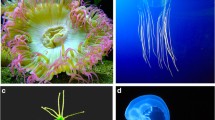Abstract
Stage I zoea larvae of Panopeus herbstii were tested for their orientations while swimming in a glass chamber and exposed to either polarized or unpolarized light. The larvae assumed a primarily vertical orientation of the dorsal spine (body axis horizontal) under all experimental conditions. Sensitivity to polarized light was demonstrated when larvae exposed to a polarization plane tilted off the horizontal shifted their orientations in the direction of the e-vector tilt. In addition, more of the larvae exposed to a horizontal e-vector were oriented to within a few degrees about the vertical direction, and they were less variable in their orientations than the populations of larvae exposed to unpolarized light. The possible ecological implications of such behavior are discussed.
Similar content being viewed by others
Literature Cited
Batschelet, E.: Statistical methods for the analysis of problems in animal orientation and certain biological rhythms, 57 pp. Washington, D.C.: American Institute of Biological Sciences 1965
Ivanoff, A. and T.H. Waterman: Factors, mainly depth and wavelength, affecting the degree of underwater light polarization. J. mar. Res. 16, 283–307 (1958)
Jander, R. and T.H. Waterman: Sensory discrimination between polarized light and light patterns by arthropods. J. cell. comp. Physiol. 56, 137–160 (1960)
Jerlov, N.G.: Optical oceanography, 194 pp. Amsterdam: Elsevier 1968
Kraft, C.H. and C. van Eeden: A nonparametric introduction to statistics, 135 pp. New York: Macmillan 1968
Lythgoe, J.N. and C.C. Hemmings: Polarized light and underwater vision. Nature, Lond. 213, 893–894 (1967)
Owen, D. B.: Handbook of statistical tables, 580 pp. Massachusetts: Addison-Wesley 1962
Siegel, S. and J.W. Tukey: A nonparametric sum of ranks procedure for relative spread in unpaired samples. J. Am. statist. Ass. 55, 429–445 (1960)
Timofeeva, V.A.: Spatial distribution of the degree of polarization of natural light in the sea. Izv. Akad. Nauk SSSR (Ser. Geofiz.) 6, 1843–1851 (1962)
Umminger, B.L.: Polarotaxis in copepods. I. An endogenous rhythm in polarotaxis in cyclops vernalis and its relation to vertical migration. Biol. Bull. mar. biol. Lab., Woods Hole 135, 239–251 (1968a)
—: Polarotaxis in copepods. II. The ultrastructural basis and ecological significance of polarized light sensitivity in copepods. Biol. Bull. mar. biol. Lab., Woods Hole 135, 252–261 (1968b)
Via, S.E. and R.B. Forward, Jr: The ontogeny and spectral sensitivity of polarotaxis in larvae of the crab Rithropanopeus harrisi (Gould). Biol. Bull. mar. biol. Lab., Woods Hole 149, 251–266 (1975)
Waterman, T.H.: Responses to polarized light: animals. In: Biology data book, Vol. II. pp 1272–1289. Ed. by P.L. Altman and D.S. Dittmer. Bethesda: Federation of American Societies for Experimental Biology 1973
Author information
Authors and Affiliations
Additional information
Communicated by M.R. Tripp, Newark
Rights and permissions
About this article
Cite this article
Bardolph, M., Stavn, R.H. Polarized light sensitivity in the stage I zoea of the mud crab Panopeus herbstii . Mar. Biol. 46, 327–333 (1978). https://doi.org/10.1007/BF00391404
Accepted:
Issue Date:
DOI: https://doi.org/10.1007/BF00391404




